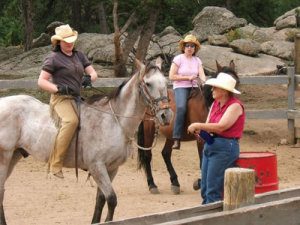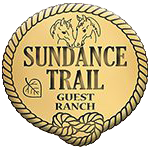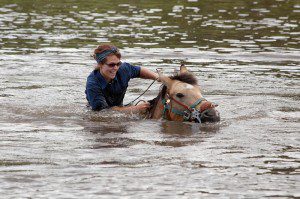
We’re not sure where we found this article, but we saved it, and we use it when we teach dude ranch riding. We have an enormous respect for Roger Thompson. He is a great teacher!
We hope he doesn’t mind us quoting him, and that you find his thoughts useful!
Horsin’ Around: The Trot
by Roger Thompson, Fort Collins, Colorado
Learning to be comfortable in a trot can sometimes be frustrating when first learning to ride. But a trot is a gate that a horse can use to cover long distances without becoming extremely winded or tired. In ranch country or in wilderness areas the trot is often used to cover long distances.
Don’t be fooled by Western movies where they run their horses all the way to town. A horse is unable to stand that sort of hard riding and will die or develop all sorts of injuries if pushed that hard.
The trot is a two-beat gait, faster than a walk, which takes more effort to control and more practice to ride comfortably.
Three methods of riding the trot are used to improve balance, rhythm and comfort. They are: a sitting trot, a standing position or two-point, and a posting trot. Many instructors ask students to use the verbal command “trot” or cluck with your tongue. Most of the time I use a clucking or kissing sound along with moving my rein hand forward and squeezing with my legs.
If the horse is unresponsive, I make a louder sound with my mouth and a harder squeeze and release, or a firm tap with the legs. Encouragement with the voice and legs may be needed to keep the horse at a steady trot. If your horse is trotting too fast use a check-release to slow him down. (Note: Here at the Sundance Trail, we use the term “bumping down” for the same breaking action.)
The same aids are used to circle or turn at a trot as when walking. Circles and turns at a trot should be larger than at a walk so your horse will not lose his balance. To slow from a trot to a walk, you may prepare him with a verbal “whoa.” But I like to shift my weight back slightly, sit deep in the saddle, and pull back firmly but gently on the reins. Be sure to give a release as your horse responds. Repeat until the horse comes to a walk. Then praise your horse.
Sitting the Trot
The Western jog and English sitting trot are ridden in the same manner. In order to “sit the trot,” it is important to both relax and sit deeply in the saddle, rotating the hips forward so as to sit on the inside of the thighs. Keep your heels and legs down so you make close contact from the crotch to the horse. The shoulders should remain over your hips and not leaning forward. Keep the back relaxed so the body can follow the horse’s movements. Some horses are so rough in the trot that sitting is almost impossible. My old bay horse is one of those and so I just stand when trotting.
Standing at the Trot
The standing position is achieved by bending forward at the hips, taking most on the weight in the ankles and heels by bending the knees at about a 45-degree angle. The back is straight with the seat just off the saddle. Be sure while standing to keep the shoulders and back relaxed. In the beginning, you may want to place a hand on your horse’s neck or grasp a hand full of mane to help maintain position. I just lay my right hand flat on the saddle-horn and take a three-point position. This position will help develop balance and strengthen your legs. Practice this at a halt and walk first. (Note: Here at the Sundance Trail we do not teach the standing trot, as dude guests put so many hours in the saddle in a short week, and this posture can be very hard in the knees. We do teach this to our long term students.)
Once, in the Texas Palo Duro Canyon with a group of college students, I used this procedure to cover a distance of three or four miles. The students were all moaning and complaining by the time we stopped, but we covered the distance in a short time.
Posting at the Trot
Posting is the motion of rising to the trot. Basically, it is a forward and back motion in which the rider’s hips move forward (out of the saddle) and back (weight in the saddle) on alternate beats at the trot. The trot can be a tiring and uncomfortable gait if the horse is rough or when the horse is being worked at a fast trot. Posting makes riding the trot easier and more comfortable for the rider and horse, if properly done.
When a horse trots, his legs move in diagonal pairs. The left foreleg and the right hind leg move forward at the same time, and the right foreleg and left hind leg move together. This makes the trot a two-beat gait. Allow the horse to push you forward (your seat will be a few inches out of the saddle) on one beat, and you will sit down in the saddle on the next beat. When posting the trot, go no higher than is necessary to get your weight out of the saddle. The forward motion of the post comes from the hips. Your knees, lower legs, and feet should be still and your heels down.
Be careful not to use the reins to pull yourself up out of the saddle, as this is hard on a horse’s mouth.
With patience and practice, you can add this to your list of riding skills.
Roger Thompson is a CHA certified instructor of advanced Western horsemanship and beginning English riding.
Wow! This all sounds so complicated! It’s not really. It just takes a bit of practice and a bit of coaching.
Here at the Sundance Trail, you will find that the wranglers follow set of “learning steps” in their care and feeding of their dude riders. (You educators call this a curriculum – but we don’t want to use words like “curriculum” when we’re being cowboys!) Your wrangler will start you with a “class” on ground manners, then communication, then practice in the arena, and so on. As you feel comfortable, and demonstrate skill in an arena and the trails, your wrangler will add new skills to learn. You will never be bored, and you will never be overwhelmed.

